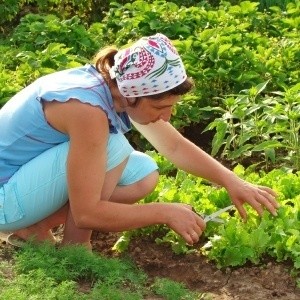Organic gardening is not just a matter of replacing synthetic fertilizers and pesticides with more natural products. It's about learning to look at your garden as a whole system and how all things are interconnected. Here are three important things new gardeners need to do to get started growing organically.
Building and maintaining soil fertility is the most important aspect of organic gardening, because soil supports plants with a steady supply of the food and water they need. Make caring for your soil your number one priority and you'll find that managing weeds and insect pests become less of a challenge.
Fertile soil is rich in organic nutrients, but it also has good texture and structure. Plant's roots should be able to penetrate the soil, water should drain properly and air should circulate freely. The soil's texture should feel crumbly and friable in your hands. Have your soil tested to learn about its type and chemistry (pH), then add compost, manure, plant and animal remains (blood meal, bone meal, fish emulsion), as necessary to improve and maintain its structure and fertility.
Sandy soil. It's gritty and doesn't hold together well in your hand. Water drains quickly.
Clay soil. Heavy and sticks together when you squeeze it in your hand. It holds moisture and stays wet and cool for a long time.
Loamy soil. It contains an equal mix of clay, sand, and silt. Loamy soil is ideal for gardening.
Every time you plant, dig, or till. When preparing a new garden bed, add a layer of compost and well-rotted manure. Apply mulch around growing plants. When your crops are done, turn over the non-diseased crop debris and mulch back into the soil. In the fall, plant a cover crop of "green manure" like red clover to protect the soil and suppress weeds. Turn it back into the soil in the spring a few weeks before planting and apply another layer of organic matter.
Not all weeds are bad. Some attract beneficial insects, and provide food and shelter to wildlife. However, when left unmanaged, weeds will dramatically reduce your yields by out-competing desirable plants for food and water. Not to mention that fact they can quickly ruin the appearance of your garden. Learn to identify weeds on sight, the conditions they thrive in, and when they reproduce (are they annuals, perennials, or biennials?), before choosing the most effective method to control them.
Remember, the idea isn't to eradicate every last weed (that would be impossible anyway), just keep them at an acceptable level.
It's important to understand that not all insects in the garden are pests. Many serve as important pollinators and feed on pest species, and help recycle nutrients for plants. Learn to identify the good guys from the bad guys, what they eat and how they eat it, and their lifecycle. In organic gardening, prevention is always the best strategy to dealing with problems.
To manage pests, practice good horticultural practices including:
Organic ways to manage pests include the use of biological controls like introducing natural predators and parasites to keep pests in check; setting up barriers and traps, and companion planting (mixing one or more plant types together for the benefit of both).

About The Author: Ellen Brown is an environmental writer and photographer and the owner of Sustainable Media, an environmental media company that specializes in helping businesses and organizations promote eco-friendly products and services. Contact her on the web at http://www.sustainable-media.com
Add your voice! Click below to comment. ThriftyFun is powered by your wisdom!
Now if we could only buy plants in containers that could be recycled! And, don't forget to try composting. Here's a link with more on that:
www.oldhouseweb.com/
Please let me give you the fourth important tip. Prior to starting a new life of organic gardener. Check when was your last anti-tetanus vaccination, if it is more than 10 years whatever your age get vaccinated against tetanus.
Add your voice! Click below to comment. ThriftyFun is powered by your wisdom!